Companies in the US spend $101B on training and development every year, but only 35% of leaders feel that workplace training is fully connected to the goals of their team. If you’re a team leader or HR professional, it can be challenging to prioritize training resources to ensure organizational needs are met and employees are equipped to thrive. A needs analysis helps you identify performance gaps so you can deliver the right solutions.
Here’s our guide to a successful needs analysis, built on top of a strong foundation of experience, expert analysis, reports, surveys, and more.
What Is a Needs Analysis?
A needs analysis is a systematic process of assessing a system, process, organization, or individual to identify deficiencies and find solutions.
‘Needs’ in this context are opportunities for improvement or gaps between the current state of things and the ideal state. The purpose is to figure out the steps required to close the gaps.
You could conduct a needs analysis on:
- a team or individual that is performing poorly
- organizational health and safety
- a customer onboarding process
- a product supply chain
- a billing software
Needs analysis is also called gap analysis or needs assessment.
Types of Training Needs Analysis
In this article, we focus on training needs analysis which is a process to identify gaps in employee training to ensure that everyone is equipped to fulfill their roles and advance organizational goals.
Training needs analysis is usually conducted by HR professionals, training departments, and team leaders. It can be divided into three categories.
- Organizational needs analysis which looks at the whole company to identify training needs.
- Team needs analysis which focuses on one team or department.
- Individual needs analysis which looks at an individual employee’s performance and skill set.
Other Types of Needs Analysis
- An organizational analysis looks beyond training to workflows, resource management, operations, structure, systems, culture, and potential strategic initiatives. This kind of analysis might be done by a leadership team or management consultants.
- A user needs analysis studies the goals, requirements, and behavior of customers or users to improve the design of products, services, software, and systems. This is a useful process for product managers, software developers, or even marketers.
- A compliance needs analysis assesses how successfully an organization is complying with government regulations and industry standards. It looks at company policies and procedures and any previous breaches of regulation to help prepare for a compliance audit. This kind of analysis is most useful in highly regulated industries like finance or air transportation and may be conducted by the legal or compliance departments alongside technicians like engineers.
- A software needs analysis assesses the gaps between a software’s objectives and its current performance. Product managers and software developers use this process to examine factors like technical features, user experience, and use cases.
As you can see, needs analysis has a wide range of applications.
Benefits of a Needs Analysis
A training needs analysis serves to benefit your organization in several ways. It can help you:
- Boost performance. More than 25% of employees say they haven’t been trained to do their jobs. Giving the right training to the right people improves job performance, but only if you correctly identify training gaps.
- Prioritize your training budget. Understanding the needs of the organization will help you prioritize the most urgent and effective training.
- Avoid wasted resources. Identifying genuine gaps rather than making assumptions helps you avoid spending time and money on training that is unnecessary, inappropriate, or overly thorough.
- Spot growth opportunities. A needs analysis can help uncover the potential for individuals, teams, or the whole organization to achieve more.
- Get ahead of disaster. Don’t wait for a lawsuit to reveal that your workforce needs better data privacy training. Conducting a thorough needs analysis helps you pick up deficiencies before they cause major problems.
- Identify struggling employees. Some people find it hard to speak up when they are finding work difficult. A needs analysis will help identify anyone who needs more training or extra support so they don’t struggle in silence or quit unexpectedly.
- Align training with business strategy. A needs analysis helps you see the bigger picture so you don’t get distracted by nice-to-haves or trending topics.
- Improve retention. Over 75% of employees say they are more likely to stay with a company that offers continuous training, but no one wants to sit through pointless training on something they already know or don’t need to know. A training program tailored to genuine employee needs, however, can improve workplace satisfaction.
When Is a Needs Analysis Conducted?
A needs analysis can be conducted routinely as part of regular strategic planning. It is also useful when:
- team or individual performance does not meet expectations
- there is a request from employees or senior leadership for new or different training
- the training budget is being reduced
- the needs of the team or organization change
- a new technology, process, or system is adopted
- a new organizational goal or project is established e.g. improve customer data collection
- the health and safety of employees is at risk (or may be at risk)
- new regulatory requirements introduce new duties
How to Perform a Needs Analysis in 7 Steps
Whether you’re a first-timer or a seasoned needs analyst, here are some simple steps to guide you through a successful needs analysis process using a systematic approach.
Step 1: Planning
First, figure out your goals. Perhaps you want to improve customer satisfaction, boost the performance of a particular team, or resolve complaints about existing training programs. Make sure your goals for the needs analysis align with current organizational goals (e.g. profits or brand image). Think about how you will measure the outcome to determine whether your analysis has been a success.
It’s crucial to evaluate the time and money available and use this information to determine the scope and methodology of the analysis. Will this be an organizational, team, or individual needs analysis? Will it cover all training areas or just one e.g. health and safety? Will you base your analysis on a few quick chats with team leaders or a combination of surveys and performance assessments?
With all that in mind, write out a plan, including deadlines for every step of the process. Check that the plan accommodates all relevant stakeholders. If you have time, get feedback from your team, subject matter experts, and team leaders, and adjust the plan accordingly.
Step 2: Establish the Ideal Situation
Ask yourself, how would things be in an ideal world? Whether your analysis is going to focus on a team, a system, or a software platform, consider what peak performance would look like and what it would require.
If you’re dealing with an individual, that means identifying the ideal performance for their job role. Look at the job description or, if you don’t have one, conduct a job analysis. Consider what tasks and objectives make up the role as well as the skills, knowledge, and abilities (KSAs) needed for excellent performance.
For example, here are the job requirements for a software engineer role at Clickout Media.
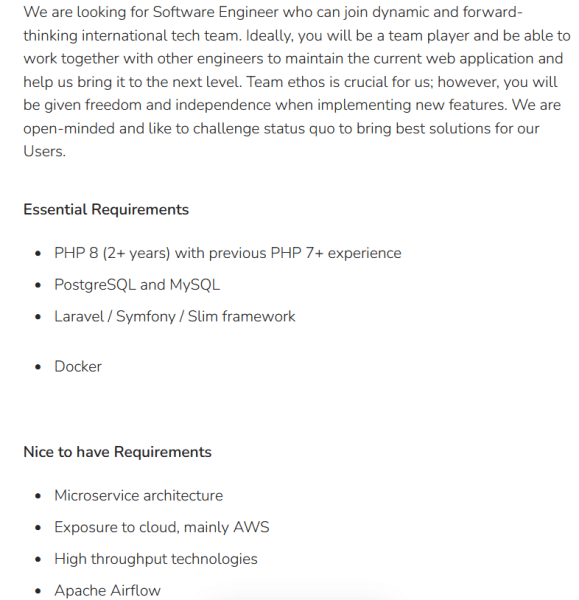
Step 3: Identify the Current Situation
The third step is to assess the actual state of things. What is the current performance of the individual, team, system, or business? There are lots of ways to collect this information including:
- performance data and KPIs
- interviews with supervisors and managers
- practical assessments
- employee self-assessment surveys
- team brainstorming sessions
- interviews with subject matter experts
- observing work or work outputs
- customer questionnaires
- customer focus groups
Choose the method that is best suited to the context and the resources you have available.
Take some time to examine relevant aspects of the current training program including the content, frequency, and format to identify what might be missing or parts of the program that are ineffective.
Step 4: Mind the Gap
Compare the current situation to the ideal situation to identify performance gaps and potential improvement areas. Ask, ‘Why aren’t things working and what is the root cause?”. Think about which gaps represent the biggest opportunity for improvement.
If you’re doing a training needs analysis, consider whether training is the right solution. Training won’t improve sales figures if you’ve got a lame product or a problematic returns policy. Ask whether the team or individual has all the necessary resources to achieve the desired outcome. Is the work environment suitable? Could a new hire fix things? Is training likely to achieve the desired outcomes?
If training is not the answer and your analysis is solely training-focused, note your findings and move on. If the scope of your analysis goes beyond training, go ahead and design the perfect solution. It could be a new recruit, new software, better incentives, or a change to the workflow or team structure.
Step 5: Determine Training Solutions
It’s time to design your training solution. Use the information you’ve gathered to tailor the content, format, and frequency of the training to the needs of your target audience. For example, employees in one job role may need more in-depth on a topic than others. Think carefully about whether an online or in-person format will be most impactful, or consider offering both to cater to different learning styles.
Think beyond a day in front of a Powerpoint in the conference room once a year. Many workers find that they learn best from training that fits into the flow of work. That could mean creating training content that is accessible at any time or introducing digital coworking as a means of remotely training new hires. Digital coworking creates a space where it’s easy to raise quick, ad hoc questions in the flow of work.
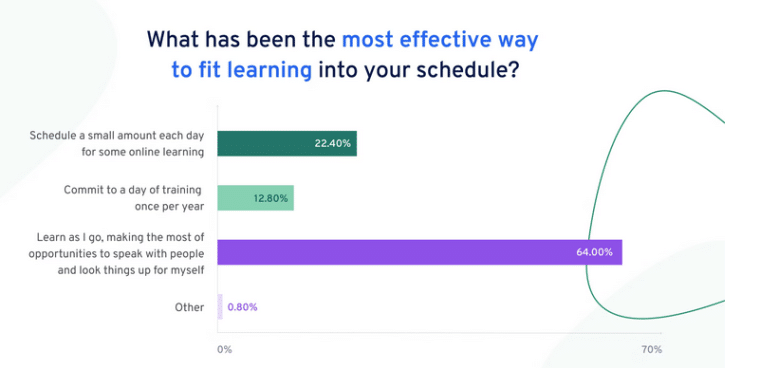
Once you’ve designed your solutions, go back to step one and check that they align with the goals you set out to achieve. It’s also a good idea to seek feedback from stakeholders and subject matter experts and adjust your plans accordingly.
Step 6: Report Your Findings
Prepare a training needs analysis report describing your process, findings, and recommendations. Include a benchmark against which you can measure future performance (e.g. the sales teams’ current sales conversion rate) and advice about how solutions should be prioritized. This will help you communicate your results with stakeholders and act as a handy record for future training analyses.
Learning and development professionals identify limited resources and support as the biggest challenges they face in facilitating learning in the flow of work. A persuasive report, backed up by concrete data, can highlight how impactful training can advance company goals which may make it easier to persuade higher-ups to approve the resources you need now and in the future.
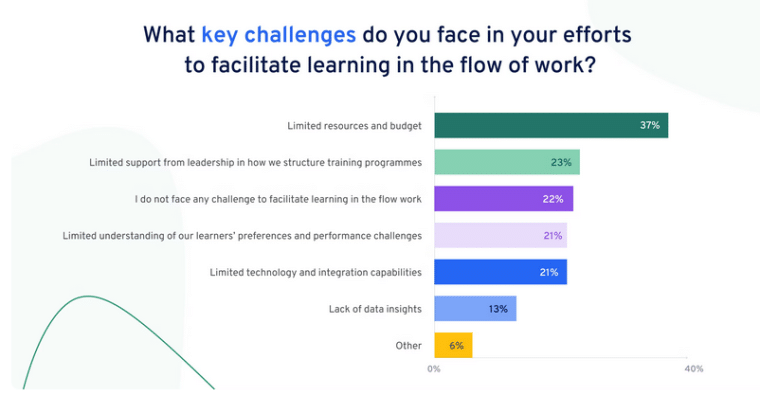
Step 7: Review and Iterate
The training needs analysis process should be iterative. Once you’ve implemented new training solutions, evaluate them to see how effective they’ve been. You can do this by:
- getting feedback from employees and supervisors
- conducting pre and post-training quizzes
- comparing pre and post-training KPIs
Reflect on whether the training outcomes represent a good ROI. Then, make the necessary improvements for future training, incorporating any changes to organizational goals.
Needs Analysis Template
Every needs assessment will look different but you could use a simple table like the one in the analysis template below, which studies an individual. Start with your goal or goals in the first column. In the next columns, break down the ‘ideal situation‘. For an individual, you can identify areas of knowledge, behaviors, and skills. The next column shows the ‘current situation’ by scoring the individual out of 5 for each skill and knowledge area. In the final column, list your training recommendations for each area.
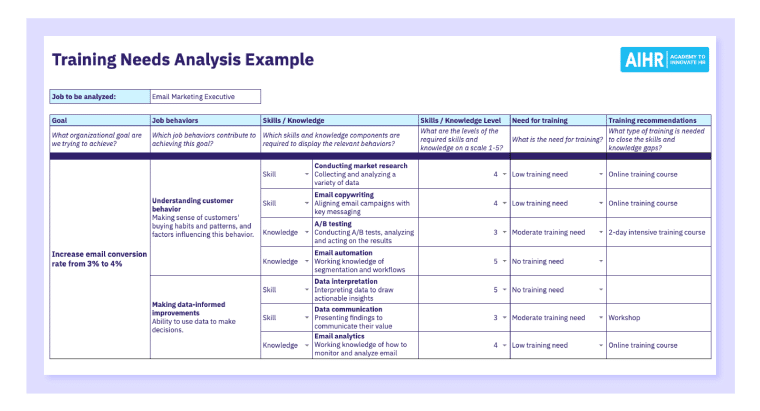
Where Is Your Organization Struggling?
If you’re conducting an organizational needs analysis and you don’t know where to focus, start by determining the areas where the business is most and least effective. One way to do this is by using a SWOT analysis which involves listing the company’s strengths, weaknesses, opportunities, and threats.
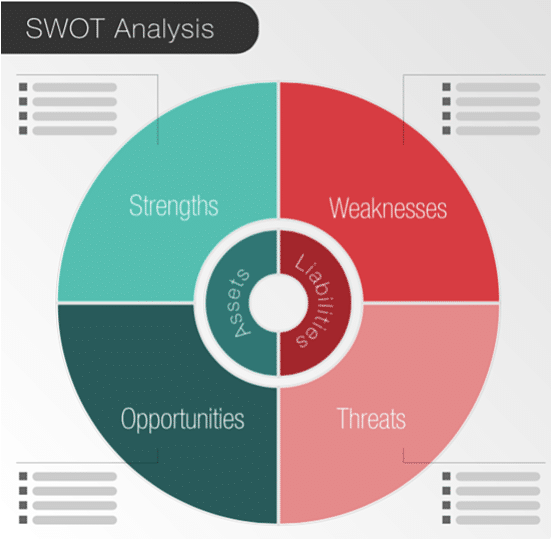
You can also use McKinsey’s 7-S Framework which breaks an organization down into seven linked and equally important elements: strategy, style, skills, systems, structure, staff, and shared values. Go through each element and assess whether that is an area that requires a needs analysis.
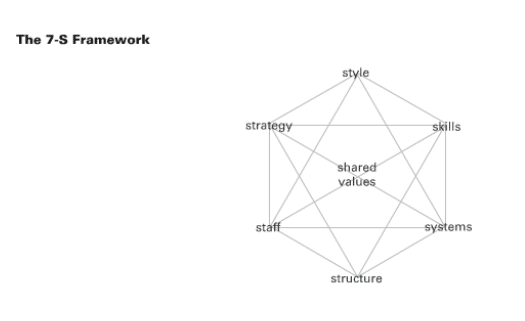
Vital Tips For a Successful Needs Analysis
Here are four tips to set you up for success.
- Manage expectations. If senior management thinks your training needs analysis is going to 10x your revenue and triple productivity overnight, they’re going to be disappointed when that doesn’t happen. Be realistic about what you can achieve and communicate that.
- Think about time. Over 40% of survey respondents say they struggle to find the time to complete training offered by their organization. Bear this in mind when designing your training program. Talk to managers to ensure employees get time to complete training during work hours. You can try microlearning, offer attendance incentives, or schedule training for quieter times of the year.
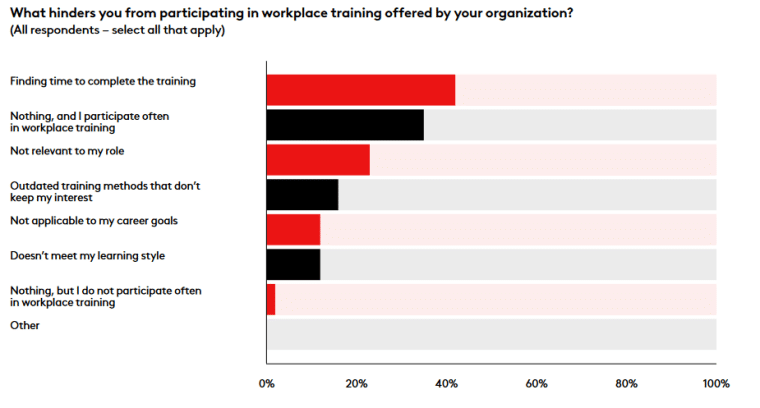
- Follow up. You might learn all the right things in training but it’s easy to slip back into old habits the moment you’re back at your desk. Design a post-training plan that reinforces new skills, rewards new behaviors, and identifies any roadblocks to change.
- Use an integrated approach. Think about how new training will be applied within the context of colleagues, customers, and systems. Ensure employees have the tools, resources, and workplace culture required to implement training effectively.
Design Solutions That Work
When we’re faced with a problem, most of us jump straight to designing solutions. That can work sometimes but it can also be a major mistake. If you step back and focus on the problem, its root causes, and the context in which it occurs, you are more likely to come up with a solution that works. A needs analysis forces you to take time, check your assumptions and see the big picture so you develop training that advances your business.
